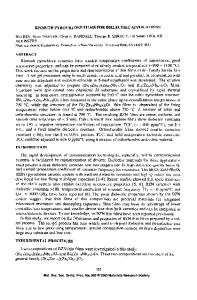Modelling of Multilayer Perforated Electrodes for Dielectric Elastomer Actuator Applications
- PDF / 521,937 Bytes
- 7 Pages / 432 x 648 pts Page_size
- 107 Downloads / 356 Views
MRS Advances © 2020 Materials Research Society DOI: 10.1557/adv.2020.210
Modelling of Multilayer Perforated Electrodes for Dielectric Elastomer Actuator Applications Seshadri Reddy Nagireddy1, Karnati Kumar Sai Charan1, Rishabh Bhooshan Mishra1, Aftab M. Hussain1* Center for VLSI and Embedded System Technologies (CVEST), International Institute of Information Technology (IIIT) Hyderabad, Telangana-500032, India *E-mail: [email protected]
Abstract Dielectric elastomer actuators (DEAs), which are inherently complaint capacitors, are emerging as pseudo-muscular actuators with a wide range of applications. In order to achieve high stretchability for large DEA actuation, carbon nanotube (CNT) and other 1D materials-based electrodes are used to maintain conductance at large strains. These electrodes are typically fabricated using spray coating or filter transfer method and resemble a perforated electrode under high magnification. Hence, there can be a loss of field and stray capacitance when multiple layers of carbon nanotubes (CNTs)-based electrodes are used. This study investigates the effect of microscopic perforations on the nature of electric fields and on the capacitance of multi-layered CNT-based DEA structures with various dimensions and geometric properties of the electrodes. It has been found that the capacitance decreases with increase in the perforations however its effect is limited for a reasonable coverage. The change in normalized is found to be negligible (~5%) for an electrode coverage area of over 90%, however, the maximum output work reduces by 18.2%. This analysis is important to develop robust and reliable CNT-based DEA structures, without using excessive CNTs which can lead to increased mechanical stiffness of the electrodes.
INTRODUCTION Since the discovery of DEAs, they have been of significant interest in the field of soft robotics as pseudo-muscular devices which have the same properties as human muscle [1-4]. DEAs consist of an electro-active polymer (EAP) sandwiched between two thin mechanically complaint electrodes. When a voltage is applied to this actuator, it converts electrical energy into mechanical energy producing large strains (Figure 1a) [57]. Thus, the electrodes should also be highly stretchable to retain the electrical conductivity even at such large strains [8-10]. Carbon nanotube (CNT) based thin films 765
Downloaded from https://www.cambridge.org/core. University of Texas Libraries, on 30 May 2020 at 03:10:05, subject to the Cambridge Core terms of use, available at https://www.cambridge.org/core/terms. https://doi.org/10.1557/adv.2020.210
are ideal for this because they are made of a mesh of individual metallic CNTs [11-13]. These thin films can be fabricated using spray coating, inkjet printing or filter transfer method. However, because of the mesh structure, these thin films resemble a perforated electrode at the microscopic level. A simple solution to this problem is to increase the areal density of the CNTs so that more individual nanotubes cover the complet
Data Loading...











